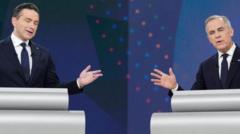In the lead-up to Canada’s general election, the anticipated second debate among the leaders of the four major parties unfolded, and US President Trump’s impact loomed large, even from afar. Liberal leader Mark Carney, previously leading the polls, faced tough questions from Conservative leader Pierre Poilievre, NDP leader Jagmeet Singh, and Bloc Québécois leader Yves-Francois Blanchet.
A significant theme emerged regarding Canada's trade relations, particularly the ongoing trade war with the US, marked by tariffs on Canadian goods. As the leaders navigated the complexities of these tariffs, Carney acknowledged the limitations of the "dollar-for-dollar" response approach and signaled a shift toward more targeted tariffs aimed at minimizing harm to Canadians while applying pressure on the US economy.
Throughout the debate, Carney's opponents seized the opportunity to connect his leadership to that of former Prime Minister Justin Trudeau, critiquing the past decade of Liberal governance by highlighting issues like housing costs and affordability. Carney defended himself, insisting on his distinct approach and leadership style, separate from Trudeau's legacy.
The debate also spotlighted important domestic policy discussions. Poilievre embraced economic growth through lower taxes and smaller government, contrasting with Singh's advocacy for enhanced social programs, including healthcare and dental care expansions. Blanchet focused on Quebec’s distinct identity, reinforcing his party's provincial priorities, while underlining a willingness to separate from Canada if needed.
The smaller parties, particularly the NDP and Bloc, are under pressure as polls show a waning support; Singh worked diligently to assert his party’s voice and agenda amidst a dominant two-party system that favors the Liberals and Conservatives. Despite these intense discussions, the overall atmosphere of the debate was marked by a surprising level of calm and civility, with leaders maintaining a cordial tone, even amidst some heated exchanges.
With the election fast approaching, the debate crystallized issues that could ultimately define the political landscape in Canada, presenting voters with distinct choices as they prepare to head to the polls.
A significant theme emerged regarding Canada's trade relations, particularly the ongoing trade war with the US, marked by tariffs on Canadian goods. As the leaders navigated the complexities of these tariffs, Carney acknowledged the limitations of the "dollar-for-dollar" response approach and signaled a shift toward more targeted tariffs aimed at minimizing harm to Canadians while applying pressure on the US economy.
Throughout the debate, Carney's opponents seized the opportunity to connect his leadership to that of former Prime Minister Justin Trudeau, critiquing the past decade of Liberal governance by highlighting issues like housing costs and affordability. Carney defended himself, insisting on his distinct approach and leadership style, separate from Trudeau's legacy.
The debate also spotlighted important domestic policy discussions. Poilievre embraced economic growth through lower taxes and smaller government, contrasting with Singh's advocacy for enhanced social programs, including healthcare and dental care expansions. Blanchet focused on Quebec’s distinct identity, reinforcing his party's provincial priorities, while underlining a willingness to separate from Canada if needed.
The smaller parties, particularly the NDP and Bloc, are under pressure as polls show a waning support; Singh worked diligently to assert his party’s voice and agenda amidst a dominant two-party system that favors the Liberals and Conservatives. Despite these intense discussions, the overall atmosphere of the debate was marked by a surprising level of calm and civility, with leaders maintaining a cordial tone, even amidst some heated exchanges.
With the election fast approaching, the debate crystallized issues that could ultimately define the political landscape in Canada, presenting voters with distinct choices as they prepare to head to the polls.






















